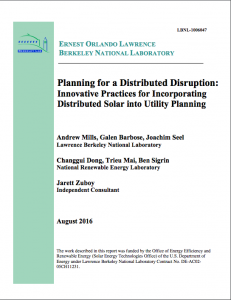Full Title: Planning for a Distributed Disruption: Innovative Practices for Incorporating Distributed Solar into Utility Planning
Author(s): Andrew Mills, Galen Barbose, Joachim Seel, Changgui Dong, Trieu Mai, Ben Sigrin, Jarett Zuboy
Publisher(s): Ernest Orlando Lawrence Berkeley National Laboratory
Publication Date: August 1, 2016
Full Text: Download Resource
Description (excerpt):
The rapid growth of distributed solar photovoltaics (DPV) has critical implications for U.S. utility planning processes. This report informs utility planning through a comparative analysis of roughly 30 recent utility integrated resource plans or other generation planning studies, transmission planning studies, and distribution system plans. It reveals a spectrum of approaches to incorporating DPV across nine key planning areas, and it identifies areas where even the best current practices might be enhanced. 1) Forecasting DPV deployment: Because it explicitly captures several predictive factors, customer-adoption modeling is the most comprehensive forecasting approach. It could be combined with other forecasting methods to generate a range of potential futures. 2) Ensuring robustness of decisions to uncertain DPV quantities: using a capacity-expansion model to develop least-cost plans for various scenarios accounts for changes in net load and the generation portfolio; an innovative variation of this approach combines multiple per-scenario plans with trigger events, which indicate when conditions have changed sufficiently from the expected to trigger modifications in resource-acquisition strategy. 3) Characterizing DPV as a resource option: Today’s most comprehensive plans account for all of DPV’s monetary costs and benefits. An enhanced approach would address non-monetary and societal impacts as well. 4) Incorporating the non-dispatchability of DPV into planning: Rather than having a distinct innovative practice, innovation in this area is represented by evolving methods for capturing this important aspect of DPV. 5) Accounting for DPV’s location-specific factors: The innovative propensity-to-adopt method employs several factors to predict future DPV locations. Another emerging utility innovation is locating DPV strategically to enhance its benefits. 6) Estimating DPV’s impact on transmission and distribution investments: Innovative practices are being implemented to evaluate system needs, hosting capacities, and system investments needed to accommodate DPV deployment. 7) Estimating avoided losses associated with DPV: A time-differentiated marginal loss rate provides the most comprehensive estimate of avoided losses due to DPV, but no studies appear to use it. 8) Considering changes in DPV’s value with higher solar penetration: Innovative methods for addressing the value changes at high solar penetrations are lacking among the studies we evaluate. 9) Integrating DPV in planning across generation, transmission, and distribution: A few states and regions have started to develop more comprehensive processes that link planning forums, but there are still many issues to address.
